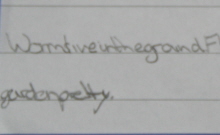
Some children find it difficult to space their letters in words correctly and to show spacing between words. Our step by step flow diagram chart will guide you through. Start from the top and working through each stage, clicking on the boxes to take you to the relevant sections of our website. Identify possible reasons for your child’s letter and spacing issues and provides suggestions on how to help them: http://bit.ly/2HtASwa
General Tips on Improving Handwriting Letter & Word Spacing:
- Using a piece of your child’s writing talk through it together, as this may help you to better understand what it is your child sees. Asking the following kind of questions and discussing the answers will help:
- Can you read this to me?
- Which letters do you think make the word/s?
- Where does one-word end and another one start?
- Can you show me the line you think the word should sit on?
- Where would you start your next line of writing?
- Which letters do you think are sitting on the line correctly?
- What gap size between letters in a word looks best?
- What gap size between words in a line of writing looks best?
- It may help to have some other examples of writing (even some you have done yourself) so that different gap and spacing sizes can be compared. Ask your child to pick the piece of writing they think looks best and seems easier to read.
- What they see and understand may be very different to what you are seeing and thought they understood.
- An explanation of how letters sit, close together in a word, may need to be discussed with your child as they may not have understood this. It is often presumed they naturally pick up and understand this writing rule.
- Once the understanding of letter spacing in words has been taught, the larger spacing between individual words is next. Often children are told to leave a finger space between each word, this is fine when a child is small and has little fingers but is not always the case. An alternative is to provide your child with an appropriate sized flat tool which they can place on the paper at the end of a word as a guide to how much space is to be left before writing the next word. Over time they will not need the tool as they have developed the spatial awareness skill for the distance needed to be left between words.
- The ideal space size between words is the size of one of their lower case letters.
- It is also useful to talk about the blank space between lines and on the page in general. Explain that these spaces and gaps help with presentation of the work so that it can be seen and read more easily.
- The correct paper tilt can help a child who is finding it hard to start each line of writing at the margin.
- Seeing the writing line properly over a whole page can be difficult for some children. Use paper with a different colour line such as red, green, blue or yellow or even black/blue lines on coloured paper.
- Paper with raised lines may help others as they feel the slight raise in the paper as they write, guiding them as to the position of the line.
- Coloured line grids and picture clues can help children learn to position letters correctly on the line and in relation to each other.